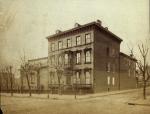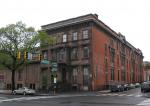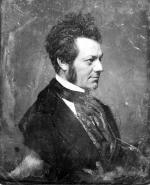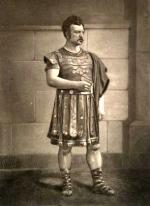![header=[Marker Text] body=[Formerly the home of actor Edwin Forrest, later Philadelphia School of Design for Women. Became Heritage House, then in 1968, Freedom Theatre, a community-based Black theater for professional instruction in the theatrical arts. ] sign](http://explorepahistory.com/kora/files/1/10/1-A-25D-139-ExplorePAHistory-a0h7x9-a_450.jpg)
Mouse over for marker text
Name:
Freedom Theatre
Region:
Philadelphia and its Countryside/Lehigh Valley
County:
Philadelphia
Marker Location:
1346 N. Broad St. (PA 611), Philadelphia
Dedication Date:
May 16, 1991
Behind the Marker
If a theater survives long enough, it's likely to play a variety of roles. The Freedom Theatre is certainly no exception. What is exceptional are the roles this nineteenth-century Italianate structure has played through the years and its enduring contribution to the community.
So, let the curtain rise on 1968, the opening scene of its current incarnation. In a remarkable year of assassination, protest, and civil unrest, this imposing stone structure that began life in 1853 as the lavish home of Edwin Forrest, the nation's first great theatrical star, was reconceived in a way that paid homage to its past, seized the fire of its present, and took the first steps toward its future as a cornerstone of what's evolved into Philadelphia's lively and eclectic Avenue of the Arts.
That year, John Allen and Robert Leslie started a new African-American theater that soon became a gathering place for black theater and arts education, and a cultural centerpiece for the city's black community. And so it remained until the early 1990s, when Yale Drama School graduate Walter Dallas helped transformed the Freedom Theatre into the New Freedom Theatre and its widely acclaimed Freedom Rep, now one of the nation's most honored black professional theater companies. Under Dallas's leadership, the Rep mounted works by James Baldwin, Charles Fuller, Ntozake Shange, Leroi Jones, Ossie Davis, August Wilson, and other African-American playwrights. Its performing-arts training program blossomed to reach as many as 800 students annually; its graduates include Gary Dourdain of television's CSI: Crime Scene Investigation and Wanya Morris of the Grammy-winning, multi-platinum singing group Boyz II Men.
August Wilson, and other African-American playwrights. Its performing-arts training program blossomed to reach as many as 800 students annually; its graduates include Gary Dourdain of television's CSI: Crime Scene Investigation and Wanya Morris of the Grammy-winning, multi-platinum singing group Boyz II Men.
It was fitting that the home of Edwin Forrest would eventually expand into a theater, for when the renowned tragedian built the house, he, just as fittingly, insisted there be a stage for his own enjoyment in the basement.
Born in Philadelphia in 1806, Forrest left school at the age of thirteen to help support the family after the death of his father. Forrest was a great imitator. At eleven, he successfully convinced an audience at the South Street Theatre that he was a girl, and at fourteen, made his professional debut on stage at the
his professional debut on stage at the  Walnut Street Theatre. Forrest spent the next several years honing his craft on the road, playing a variety of roles, including several in blackface, in frontier theaters from Pittsburgh to New Orleans.
Walnut Street Theatre. Forrest spent the next several years honing his craft on the road, playing a variety of roles, including several in blackface, in frontier theaters from Pittsburgh to New Orleans.
His true theatrical education began in Albany in 1825, when he was hired to support the legendary English Shakespearean actor Edmund Kean, who was touring the United States. Impressed by Forrest's raw talent, wild temperament, and rugged good looks, Kean took the American under his wing, casting him as Iago to his own Othello. Forrest, in turn, embraced Kean's flamboyant stage style, filled with the florid orations and histrionics that meshed so well with Forrest's own personality. A year later, Forrest was starring in New York's most prestigious theater, the Park, as Othello, and was soon headlining at the lower-brow Bowery Theatre for an unheard of $200 a night. By 1829, he was back at the Park, now a wealthy man. Forrest used his newfound riches to seed American plays written by American playwrights, including one, The Gladiator, that provided him with one of his signature roles, Spartacus.
Spartacus.
In 1834, Forrest took Spartacus to London's Drury Lane Theatre. The first American to star on the London stage, he was a sensation. The distinguished actress Fanny Kemble dubbed him "a mountain of a man," and he was entertained royally by London's theatrical lights, including William Macready, second only to Kean as Britain's reigning thespian. Forrest remained in London for three years and there met and married his wife Catherine Norton Sinclair.
Back in New York, his performances set records, earning more than $4,000 in one three-night stint at the Park. In 1845, the Forrests returned to London, where his odd, tragic dance with Macready began. Appearing as MacBeth, he was booed ferociously one night. Forrest decided that the vain and temperamental Macready so resented his success that he had orchestrated the audiences' insults. Several months later, when Macready was playing Hamlet in Edinburgh, Forrest returned the raspberry.
Three years later the actors' feud exploded into deadly violence when Macready toured the United States as Macbeth. In the mid-1800s theater was a highly participatory activity. American audiences regularly interrupted performances, demanded that performers repeat their favorite songs or soliloquies, and loudly booed - or attacked - performers who displeased them. Americans took their theater very seriously, and were quick to take offense at insults to national pride. In May, 1849, Macready and Forrest were both playing in New York - Macready at the Astor Place Opera House and Forrest at the nearby Broadway Theatre. During Macready's final performance, a mob of more than 1,000 gathered outside Astor Place and began stoning the theater. When the National Guard arrived to restore order, the rioting began in earnest. By the next morning, at least twenty-two lay dead, and as many as 150 were wounded.
A rumor that had encouraged the rioters damaged Forrest's reputation, and his popularity. And then things then got worse. In late 1851, his very public and very ugly six-month divorce trial began - he had found his wife with another actor. The ensuing revelations filled the papers, then continued through six appeals, all of which he lost, and a libel suit. The scandal, however, only refueled Forrest; back on stage, he would step from the curtain between acts to grandly justify his behavior. Once again, he was a smash, selling out sixty-nine consecutive performances.
Then he began to fade away between intermittent triumphant tours. In 1853, he began building his great stone refuge in Philadelphia. He would return here between engagements - including his 1860 return to New York as Hamlet and an 1866 tour that took him to San Francisco; surrounded by its stone walls, he would, in the words of a contemporary, "brood upon himself as a great genius misunderstood, and the rest of the world as sort of animated scum." Forrest died in his house, alone, in 1872, willing that his estate - including the house - become a home for retired actors.
So, let the curtain rise on 1968, the opening scene of its current incarnation. In a remarkable year of assassination, protest, and civil unrest, this imposing stone structure that began life in 1853 as the lavish home of Edwin Forrest, the nation's first great theatrical star, was reconceived in a way that paid homage to its past, seized the fire of its present, and took the first steps toward its future as a cornerstone of what's evolved into Philadelphia's lively and eclectic Avenue of the Arts.
That year, John Allen and Robert Leslie started a new African-American theater that soon became a gathering place for black theater and arts education, and a cultural centerpiece for the city's black community. And so it remained until the early 1990s, when Yale Drama School graduate Walter Dallas helped transformed the Freedom Theatre into the New Freedom Theatre and its widely acclaimed Freedom Rep, now one of the nation's most honored black professional theater companies. Under Dallas's leadership, the Rep mounted works by James Baldwin, Charles Fuller, Ntozake Shange, Leroi Jones, Ossie Davis,
It was fitting that the home of Edwin Forrest would eventually expand into a theater, for when the renowned tragedian built the house, he, just as fittingly, insisted there be a stage for his own enjoyment in the basement.
Born in Philadelphia in 1806, Forrest left school at the age of thirteen to help support the family after the death of his father. Forrest was a great imitator. At eleven, he successfully convinced an audience at the South Street Theatre that he was a girl, and at fourteen, made
His true theatrical education began in Albany in 1825, when he was hired to support the legendary English Shakespearean actor Edmund Kean, who was touring the United States. Impressed by Forrest's raw talent, wild temperament, and rugged good looks, Kean took the American under his wing, casting him as Iago to his own Othello. Forrest, in turn, embraced Kean's flamboyant stage style, filled with the florid orations and histrionics that meshed so well with Forrest's own personality. A year later, Forrest was starring in New York's most prestigious theater, the Park, as Othello, and was soon headlining at the lower-brow Bowery Theatre for an unheard of $200 a night. By 1829, he was back at the Park, now a wealthy man. Forrest used his newfound riches to seed American plays written by American playwrights, including one, The Gladiator, that provided him with one of his signature roles,
In 1834, Forrest took Spartacus to London's Drury Lane Theatre. The first American to star on the London stage, he was a sensation. The distinguished actress Fanny Kemble dubbed him "a mountain of a man," and he was entertained royally by London's theatrical lights, including William Macready, second only to Kean as Britain's reigning thespian. Forrest remained in London for three years and there met and married his wife Catherine Norton Sinclair.
Back in New York, his performances set records, earning more than $4,000 in one three-night stint at the Park. In 1845, the Forrests returned to London, where his odd, tragic dance with Macready began. Appearing as MacBeth, he was booed ferociously one night. Forrest decided that the vain and temperamental Macready so resented his success that he had orchestrated the audiences' insults. Several months later, when Macready was playing Hamlet in Edinburgh, Forrest returned the raspberry.
Three years later the actors' feud exploded into deadly violence when Macready toured the United States as Macbeth. In the mid-1800s theater was a highly participatory activity. American audiences regularly interrupted performances, demanded that performers repeat their favorite songs or soliloquies, and loudly booed - or attacked - performers who displeased them. Americans took their theater very seriously, and were quick to take offense at insults to national pride. In May, 1849, Macready and Forrest were both playing in New York - Macready at the Astor Place Opera House and Forrest at the nearby Broadway Theatre. During Macready's final performance, a mob of more than 1,000 gathered outside Astor Place and began stoning the theater. When the National Guard arrived to restore order, the rioting began in earnest. By the next morning, at least twenty-two lay dead, and as many as 150 were wounded.
A rumor that had encouraged the rioters damaged Forrest's reputation, and his popularity. And then things then got worse. In late 1851, his very public and very ugly six-month divorce trial began - he had found his wife with another actor. The ensuing revelations filled the papers, then continued through six appeals, all of which he lost, and a libel suit. The scandal, however, only refueled Forrest; back on stage, he would step from the curtain between acts to grandly justify his behavior. Once again, he was a smash, selling out sixty-nine consecutive performances.
Then he began to fade away between intermittent triumphant tours. In 1853, he began building his great stone refuge in Philadelphia. He would return here between engagements - including his 1860 return to New York as Hamlet and an 1866 tour that took him to San Francisco; surrounded by its stone walls, he would, in the words of a contemporary, "brood upon himself as a great genius misunderstood, and the rest of the world as sort of animated scum." Forrest died in his house, alone, in 1872, willing that his estate - including the house - become a home for retired actors.











